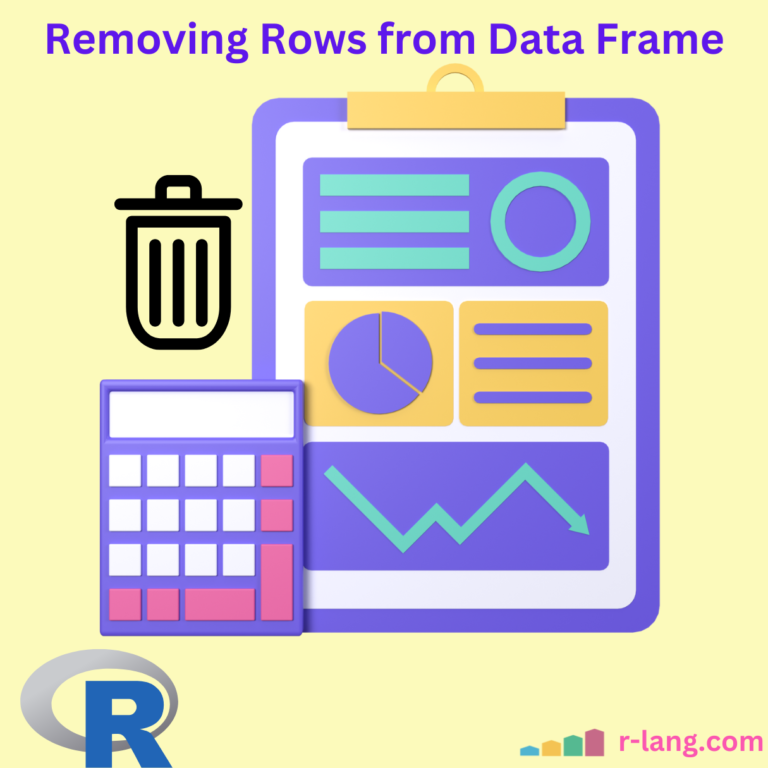The best and most efficient way to remove rows from a data frame is using “negative indexing”. It is a base R approach that does not require any packages.
However, there are different approaches you should be aware of, depending on the situation you are encountering.
Here are five ways:
- Using negative indexing (For single or multiple rows)
- Removing rows by name
- Using subset() function
- Using dplyr package
- Using the na.omit() function (For removing rows with NA values)
Method 1: Using negative indexing
Negative sign (-) means exclusion. If you have a data frame df and you want to remove the first row, you just need to write df[-1, ].
For multiple rows, use df[-c(1,3,5), ], which will remove rows 1, 3, and 5. It is a removal by row number. The c() function combines the indices, and the negative sign excludes them.
It is the process of accessing a data frame without specifying some rows using a negative index. This is also called row indexing.
Syntax
df[-c(row_index_1, row_index_2),]Removing a single row (By row number)
df <- data.frame(
Shares = c("TCS", "Reliance", "HDFC Bank", "HUL", "KPIT"),
Price = c(3200, 1900, 1500, 2200, 1400)
)
df_remain <- df[-c(3), ]
df_remainRemoving multiple rows (By row numbers)
To remove the second and third rows, use -c(2, 3). The negative sign before c(2, 3) tells R to exclude those rows.
df <- data.frame(
Shares = c("TCS", "Reliance", "HDFC Bank", "HUL", KPIT),
Price = c(3200, 1900, 1500, 2200, 1400)
)
df_remain <- df[-c(2, 3),]
df_remainUsing range
If you want to remove multiple rows, you can define them as a range. For example, -c(2:4) refers to the sequence of rows (rows 2, 3, and 4) that will be excluded from the data frame.
df <- data.frame(
Shares = c("TCS", "Reliance", "HDFC Bank", "HUL", "KPIT"),
Price = c(3200, 1900, 1500, 2200, 1400)
)
modified_df <- df[-c(2:4), ]
modified_df
Method 2: Removing rows by name
If you have a data frame that contains row names, you can remove the row by its name using the which() function. To get the specific row name, use the rownames() function.
df <- data.frame(
Shares = c("TCS", "Reliance", "HDFC Bank", "HUL", "KPIT"),
Price = c(3200, 1900, 1500, 2200, 1400)
)
rownames(df) <- c("row1", "row2", "row3", "row4", "row5")
cat("After removing 4th row", "\n")
modified_df <- df[-which(rownames(df) == "row4"), ]
modified_dfMethod 3: Using the subset() function
The subset() function is helpful when you have a specific logical condition. It removes only the rows that meet that condition.
To properly use the subset() function, you must provide a logical expression that evaluates FALSE for the rows you want to remove.
df <- data.frame(
Shares = c("TCS", "Reliance", "HDFC Bank", "HUL", "KPIT"),
Price = c(3200, 1900, 1500, 2200, 1400)
)
df_after_removed <- subset(df, Price > 1900)
df_after_removed
Method 4: Using the dplyr package
If you already use the dplyr package in your program, then you can use the dplyr package’s filter() or slice() function.
Using dplyr::filter()
You can pass the condition using a logical expression to the filter() function, which will filter out the rows for you.
library(dplyr)
df <- data.frame(
Shares = c("TCS", "Reliance", "HDFC Bank", "HUL", "KPIT"),
Price = c(3200, 1900, 1500, 2200, 1400)
)
filtered_df <- df %>% filter(Price > 1400)
filtered_dfPass the indices you want to remove in the slice() function, and it will remove it from the data frame.
library(dplyr)
df <- data.frame(
Shares = c("TCS", "Reliance", "HDFC Bank", "HUL", "KPIT"),
Price = c(3200, 1900, 1500, 2200, 1400)
)
# Remove rows using slice()
df_sliced <- df %>%
slice(-c(1, 4, 5)) # Exclude rows 1, 4, ands 5
print(df_sliced)
Output
Shares Price
1 Reliance 1900
2 HDFC Bank 1500
Removing duplicate rows
Check out removing duplicate rows from the data frame article for more information.
Method 5: Using the na.omit() function
If you want to quickly remove rows with NA values, use the built-in na.omit() function. For more targeted NA removal, I recommend using the complete.cases() or tidyr::drop_na() functions.
df <- data.frame(
Shares = c("TCS", "Reliance", "HDFC Bank", NA, "KPIT"),
Price = c(3200, 1900, 1500, NA, 1400)
)
df_na_removed <- na.omit(df)
df_na_removedThat’s it!

Krunal Lathiya is a seasoned Computer Science expert with over eight years in the tech industry. He boasts deep knowledge in Data Science and Machine Learning. Versed in Python, JavaScript, PHP, R, and Golang. Skilled in frameworks like Angular and React and platforms such as Node.js. His expertise spans both front-end and back-end development. His proficiency in the Python language stands as a testament to his versatility and commitment to the craft.








